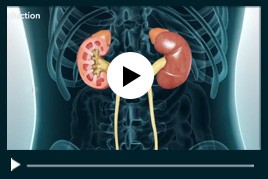Kidney
The kidneys are situated in the posterior part of the abdomen, one on either side of the vertebral column (spine) and surrounded by a mass of fat and loose areolar tissue.
Each kidney is about 11.25 cm. in length, 5 to 7.5 cm. in breadth, and rather more than 2.5 cm. in thickness. The left is somewhat longer, and narrower, than the right. The weight of the kidney in the adult male varies from 125 to 170 gm., in the adult female from 115 to 155 gm. The combined weight of the two kidneys in proportion to that of the body is about 1 to 240.
Healthy kidneys clean your blood by removing excess fluid, minerals, and wastes. They also make hormones that keep your bones strong and your blood healthy. When your kidneys fail, harmful wastes build up in your body, your blood pressure may rise, and your body may retain excess fluid and not make enough red blood cells. When this happens, you need treatment to replace the work of your failed kidneys.
With a slow connection, it may take about a minute to download this presentation.
Below are some some common conditions, diagnostics and treatments in relation to the kidneys. Some of topics below are discussed elsewhere, click on the link to go to that section.
Renal biopsy
Also called as Kidney Biopsy, Renal biopsy means to obtain a sample of the kidney tissue. The sample is then examined in the laboratory. Renal biopsies require special collection procedures and should be done only in centres with appropriate facilities and after consultation with the pathologist.
- Indications for Renal biopsy
- Presence of protein and/or blood in the urine in stable patients.
- Unexplained acute renal failure.
- Rejection in renal transplantation.
- How the test is performed
This test is done in the hospital, usually in the radiology suite in ultrasound. You will be expected to follow the instructions given during the test. You will be lying face down on a firm surface. Firm pillows or a rolled towel may be placed beneath the abdominal area to give support.
The kidney is located under ultrasound, and then the health care provider will mark the biopsy site. A local anaesthetic will be given to numb the skin at the biopsy site. A tiny incision is then made in the skin.
You will be asked to take a deep breath, hold it, and remain still as the locating needle (a needle that is used to locate the proper location in the kidney) is inserted through the incision and into the kidney under ultrasound guidance. You will then be asked to take several deep breaths to help verify the position of the needle.
The locating needle depth is measured and then removed. The biopsy needle is inserted following the path of the locating needle. Again, the position of the needle will be verified. The sample is taken, and the needle is removed. Pressure is applied to the biopsy site to stop the bleeding, and a bandage is applied. You will remain in the hospital after the test and lie on your back for 12 to 24 hours.
Contraindications
It is contraindicated in the presence of single kidney, bleeding disorders or uncontrolled hypertensions.
Complications of a renal biopsy
The most important complication after the procedure or hematuria is bleeding, this usually occurs in 5 to 10% of patients and resolves uneventfully in 24 to 48 hours. Rarely is the bleeding so severe as to requiring blood transfusions.

 Menu
Menu




